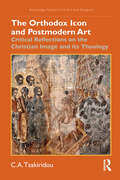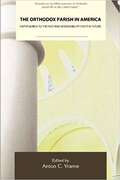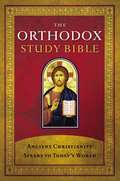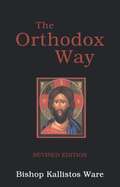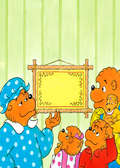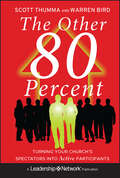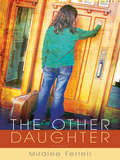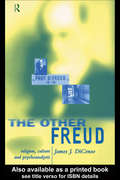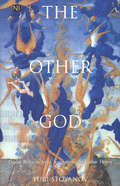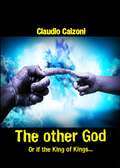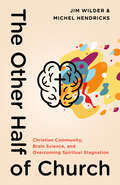- Table View
- List View
The Orthodox Icon and Postmodern Art: Critical Reflections on the Christian Image and its Theology (Routledge Research in Art and Religion)
by C.A. TsakiridouThis study examines the theories of postmodern visuality and representation and identifies concepts that resonate with Orthodox theology and iconography.C.A. Tsakiridou frees the Orthodox icon from iconological precepts that limit its aesthetic and expressive range. The book’s key argument is that poststructuralist thought is not alien to Orthodox theology and iconography. Dissonance, liminality, and ambiguity are essential for conveying the paradoxes of Christian faith and recognizing the hagiopneumatic vitality and openness of the Orthodox tradition. Perichoresis or coinherence, a concept in patristic theology that defines the relationship between the three persons of the Holy Trinity and the two natures of Christ, acquires a feminine dimension in the person of the Theotokos. Like the ascetical concept of nepsis, it has aesthetic implications. Intermedial qualities present in iconography, photography, and cinema help explain how icons become hosts to transcendent realities and how their experience in Orthodox liturgy and devotion has anticipated and resolved the postmodern disorientation of visuality and representation.The book will be of interest to scholars working in art history, postmodernism, philosophy, theology, religion, and gender studies.
The Orthodox Parish In America: Faithfulness To The Past And Responsibility For The Future
by Anton C. VrameThe Orthodox Parish in America: Faithfulness to the Past and Responsibility for the Future
The Orthodox Parish In America: Faithfulness To The Past And Responsibility For The Future
by Anton C. VrameOrthodox parish life in North America, particularly in the United States, challenges many traditional assumptions as to how the church functions. The parish as a public corporate entity, the expanding roles of lay and ordained leadership, the coexistence of multiple jurisdictions-all of these are new realities for Orthodox Christianity. This volume addresses these and other related issues. Historians such as John Erickson, Thomas FitzGerald and Patrick Viscuso analyze the factors that have shaped these realities in America, from earlier eras to the present day. Theologians such as Thomas Hopko, Jaroslav Pelikan and Stanley Harakas reflect on the theological significance and implications for the Orthodox Christian understanding of the church's very nature. Liturgical scholars Alkiviadis Calivas, John Klentos and Paul Meyendorff discuss the challenges of liturgical life in today's Orthodox parish. Thomas Lelon and George Papademetriou examine parish management and leadership issues. Other essays address topics such as distance learning and the Internet, interChristian marriage, preaching, evangelization and mission. This book provides an excellent, realistic overview of contemporary Orthodox parish life in the United States, and a thought-provoking look at diverse scenarios for the future.
The Orthodox Study Bible: Ancient Christianity Speaks to Today's World
by Thomas NelsonThe FIRST EVER Orthodox Study Bible presents the Bible of the early church and the church of the early Bible.Orthodox Christianity is the face of ancient Christianity to the modern world and embraces the second largest body of Christians in the world. In this first-of-its-kind study Bible, the Bible is presented with commentary from the ancient Christian perspective that speaks to those Christians who seek a deeper experience of the roots of their faith.Features Include:Old Testament newly translated from the Greek text of the Septuagint, including the DeuterocanonNew Testament from the New King James VersionCommentary drawn from the early Church ChristiansEasy-to-Locate liturgical readingsBook Introductions and OutlinesSubject IndexFull-color IconsFull-color Maps
The Orthodox Way
by Kallistos T. WareA classic accounts of the belief, worship and life of the Orthodox Church. Discusses God as hidden yet revealed, the problem of evil, the nature of salvation, the meaning of faith, prayer, death and what lies beyond.
The Osos Berenstain y la regla de oro/and the Golden Rule: Level 1 (Los Osos Berenstain)
by Stan Berenstain w/ Mike Berenstain¿Debería Hermana Oso ignorar a la nueva compañerita en la escuela simplemente porque sus amigas lo hacen? Los osos Berenstain y la regla de oro muestran a los niños cómo la decisión de ser amable tal vez no sea siempre fácil; pero siempre es la correcta.
The Osos Berenstain, Dios te ama / God Loves You
by Stan Berenstain w/ Mike BerenstainEn ¡Dios te ama!, Hermano y Hermana Oso descubren que Dios los ama, no debido a que tengan éxito, sino porque él los hizo. Este libro ayuda a los niños a apreciar las muchas manera en que Dios les muestra su amor. In God Loves You! Brother and Sister Bear discover that God loves them, not because they’re successful, but because he made them. This book helps children appreciate the many ways God shows his love to them.
The Other 80 Percent
by Warren Bird Scott ThummaA research-based approach to developing more active and involved congregationsIn this practical resource, well-known and respected researcher Scott Thumma and professional co-writer Warren Bird draw upon new and heretofore unpublished research across a broad range of Protestant churches of all sizes and show how to create more active members. Offers solid information of what church leaders need to know about the factors and practices that create church members who are more actively and passionately involved in their congregations.Offers a first of its kind resource for developing engaged congregations Lead author Scott Thumma is a noted researcher and writer on congregational studiesWarren Bird is coauthor of Culture Shift and Viral ChurchesThis book offers advice for moving church members from being spectators to living a life of discipleship and faith.
The Other Catholics: Remaking America's Largest Religion
by Julie ByrneIndependent Catholics are not formally connected to the pope in Rome. They practice apostolic succession, seven sacraments, and devotion to the saints. But without a pope, they can change quickly and experiment freely, with some affirming communion for the divorced, women's ordination, clerical marriage, and same-sex marriage. From their early modern origins in the Netherlands to their contemporary proliferation in the United States, these "other Catholics" represent an unusually liberal, mobile, and creative version of America's largest religion.In The Other Catholics, Julie Byrne shares the remarkable history and current activity of independent Catholics, who number at least two hundred communities and a million members across the United States. She focuses in particular on the Church of Antioch, one of the first Catholic groups to ordain women in modern times. Through archival documents and interviews, Byrne tells the story of the unforgettable leaders and surprising influence of these understudied churches, which, when included in Catholic history, change the narrative arc and total shape of modern Catholicism. As Pope Francis fights to soften Roman doctrines with a pastoral touch and his fellow Roman bishops push back with equal passion, independent Catholics continue to leap ahead of Roman reform, keeping key Catholic traditions but adding a progressive difference.
The Other Catholics: Remaking America's Largest Religion
by Julie Byrne&“An excellent study of churches on the fringe that incubate new ideas and shed new light on mainstream religion.&”—Times Higher Education Independent Catholics are not formally connected to the pope in Rome. They practice apostolic succession, seven sacraments, and devotion to the saints. But without a pope, they can change quickly and experiment freely—with some affirming communion for the divorced, women&’s ordination, clerical marriage, and same-sex marriage. From their early modern origins in the Netherlands to their contemporary proliferation in the United States, these &“other Catholics&” represent an unusually liberal, mobile, and creative version of America&’s largest religion. In The Other Catholics, Julie Byrne shares the remarkable history and current activity of independent Catholics, who number at least two hundred communities and a million members across the United States. She focuses in particular on the Church of Antioch, one of the first Catholic groups to ordain women in modern times. Through archival documents and interviews, Byrne tells the story of the unforgettable leaders and surprising influence of these understudied churches, which, when included in Catholic history, change the narrative arc and total shape of modern Catholicism. As Pope Francis fights to soften Roman doctrines with a pastoral touch and his fellow Roman bishops push back with equal passion, independent Catholics continue to leap ahead of Roman reform, keeping key Catholic traditions but adding a progressive difference. &“Byrne&’s enlightening research and analysis will undoubtedly raise awareness of these little-known Catholic denominations.&”
The Other Daughter: A Novel
by Miralee FerrellSusanne Carson's well-ordered family life is thrown into devastating chaos when Brianna, a young teen, appears on her doorstep, claiming to be the daughter of Susanne's husband, David. The revelation of David's apparent betrayal adds strain to an already fragile marriage. Will this shocking discovery drive the family apart, or will it draw them closer to God? Guaranteed fiction!
The Other Emptiness: Rethinking the Zhentong Buddhist Discourse in Tibet
by Michael R. Sheehy; Klaus-Dieter MathesThis book brings together perspectives of leading international Tibetan studies scholars on the subject of zhentong or "other-emptiness." Defined as the emptiness of everything other than the continuous luminous awareness that is one's own enlightened nature, this distinctive philosophical and contemplative presentation of emptiness is quite different from rangtong—emptiness that lacks independent existence, which has had a strong influence on the dissemination of Buddhist philosophy in the West. Important topics are addressed, including the history, literature, and philosophy of emptiness that have contributed to zhentong thinking in Tibet from the thirteenth century until today. The contributors examine a wide range of views on zhentong from each of the major orders of Tibetan Buddhism, highlighting the key Tibetan thinkers in the zhentong philosophical tradition. Also discussed are the early formulations of buddhanature, interpretations of cosmic time, polemical debates about emptiness in Tibet, the zhentong view of contemplation, and creative innovations of thought in Tibetan Buddhism. Highly accessible and informative, this book can be used as a scholarly resource as well as a textbook for teaching graduate and undergraduate courses on Buddhist philosophy.
The Other Evangelicals: A Story of Liberal, Black, Progressive, Feminist, and Gay Christians—and the Movement That Pushed Them Out
by Isaac B. SharpWhat&’s the first thing that comes to mind when you hear &“evangelical&”?For many, the answer is &“white,&” &“patriarchal,&” &“conservative,&” or &“fundamentalist&”—but as Isaac B. Sharp reveals, the &“big tent&” of evangelicalism has historically been much bigger than we&’ve been led to believe. In The Other Evangelicals, Sharp brings to light the stories of those twentieth-century evangelicals who didn&’t fit the mold, including Black, feminist, progressive, and gay Christians.Though the binary of fundamentalist evangelicals and modernist mainline Protestants is taken for granted today, Sharp demonstrates that fundamentalists and modernists battled over the title of &“evangelical&” in post–World War II America. In fact, many ideologies characteristic of evangelicalism today, such as &“biblical womanhood&” and political conservatism, arose only in reaction to the popularity of evangelical feminism and progressivism. Eventually, history was written by the &“winners&”—the Billy Grahams of American religion—while the &“losers&” were expelled from the movement via the establishment of institutions such as the National Association of Evangelicals.Carefully researched and deftly written, The Other Evangelicals offers a breath of fresh air for scholars seeking a more inclusive history of religion in America.
The Other Freud: Religion, Culture and Psychoanalysis
by James DiCensoFirst published in 1998. Routledge is an imprint of Taylor & Francis, an informa company.
The Other God
by Mr Yuri StoyanovThis fascinating book explores the evolution of religious dualism, the doctrine that man and cosmos are constant battlegrounds between forces of good and evil. It traces this evolution from late Egyptian religion and the revelations of Zoroaster and the Orphics in antiquity through the Dead Sea Scrolls, the Mithraic Mysteries, and the great Gnostic teachers to its revival in medieval Europe with the suppression of the Bogomils and the Cathars, heirs to the age-long teachings of dualism. Integrating political, cultural, and religious history, Yuri Stoyanov illuminates the dualist religious systems, recreating in vivid detail the diverse worlds of their striking ideas and beliefs, their convoluted mythologies and symbolism. Reviews of an earlier edition:"A book of prime importance for anyone interested in the history of religious dualism. The author's knowledge of relevant original sources is remarkable; and he has distilled them into a convincing and very readable whole."--Sir Steven Runciman"The most fascinating historical detective story since Steven Runciman's Sicilian Vespers."--Colin Wilson"A splendid account of the decline of the dualist tradition in the East . . . both strong and accessible. . . . The most readable account of Balkan heresy ever."--Jeffrey B. Russell, Journal of Religion "Well-written, fact-filled, and fascinating . . . has in it the making of a classic."--Harry T. Norris, Bulletin of SOAS
The Other God: Or If The King Of Kings...
by Claudio CalzoniThe Other God Or If The King Of Kings... by Claudio Calzoni What would have happened if the life of the God who changed the history of man had been different? Claudio Calzoni elaborates an alternative future, a sliding door, for the Divine Being that is the basis of every modern society. The Other God Or If The King Of Kings... What would have happened if the life of the God who changed the history of man had been different? Claudio Calzoni elaborates an alternative future, a sliding door, for the Divine Being that is the basis of every modern society.
The Other Half of Church: Christian Community, Brain Science, and Overcoming Spiritual Stagnation
by Jim Wilder Michel HendricksCould brain science be the key to spiritual formation?Why does true Christian transformation seem fleeting? And why does church often feel lonely, Christian community shallow, and leaders untrustworthy? For many Christians, the delight of encountering Christ eventually dwindles—and disappointment sets in. Is lasting joy possible?These are some of the questions Michel Hendricks has considered both in his experience as a spiritual formation pastor and in his lifetime as a Christian. He began to find answers when he met Jim Wilder—a neurotheologian. Using brain science, Wilder identified that there are two halves of the church: the rational half and the relational half. And when Christians only embrace the rational half, churches become unhealthy places where transformation doesn&’t last and narcissistic leaders flourish.In The Other Half of Church, join Michel and Jim's journey as they couple brain science with the Bible to identify how to overcome spiritual stagnation by living a full-brained faith. You'll also learn the four ingredients necessary to develop and maintain a vibrant transformational community where spiritual formation occurs, relationships flourish, and the toxic spread of narcissism is eradicated.
The Other Half of Church: Christian Community, Brain Science, and Overcoming Spiritual Stagnation
by Jim Wilder Michel HendricksCould brain science be the key to spiritual formation?Why does true Christian transformation seem fleeting? And why does church often feel lonely, Christian community shallow, and leaders untrustworthy? For many Christians, the delight of encountering Christ eventually dwindles—and disappointment sets in. Is lasting joy possible?These are some of the questions Michel Hendricks has considered both in his experience as a spiritual formation pastor and in his lifetime as a Christian. He began to find answers when he met Jim Wilder—a neurotheologian. Using brain science, Wilder identified that there are two halves of the church: the rational half and the relational half. And when Christians only embrace the rational half, churches become unhealthy places where transformation doesn&’t last and narcissistic leaders flourish.In The Other Half of Church, join Michel and Jim's journey as they couple brain science with the Bible to identify how to overcome spiritual stagnation by living a full-brained faith. You'll also learn the four ingredients necessary to develop and maintain a vibrant transformational community where spiritual formation occurs, relationships flourish, and the toxic spread of narcissism is eradicated.
The Other New York Jewish Intellectuals (Reappraisals Jewish Social History)
by Carole S KessnerIrving Howe. Saul Bellow. Lionel Trilling. These are names that immediately come to mind when one thinks of the New York Jewish intellectuals of the late thirties and forties. And yet the New York Jewish intellectual community was far larger and more diverse than is commonly thought. In The Other New York Jewish Intellectuals we find a group of thinkers who may not have had widespread celebrity status but who fostered a real sense of community within the Jewish world in these troubled times. What unified these men and women was their commitment and allegiance to the Jewish people. Here we find Hayim Greenberg, Henry Hurwitz, Marie Syrkin, Maurice Samuel, Ben Halperin, Trude Weiss-Rosmarin, Morris Raphael Cohen, Ludwig Lewisohn, Milton Steinberg, Will Herberg, A. M. Klein, and Mordecai Kaplan, and many others. Divided into 3 sections--Opinion Makers, Men of Letters, and Spiritual Leaders--the book will be of particular interest to students and others interested in Jewish studies, American intellectual history, as well as history of the 30s and 40s.
The Other Ramayana Women: Regional Rejection and Response (Routledge Hindu Studies Series)
by John Brockington and Mary BrockingtonThis book is the first to present current scholarship on gender and in regional and sectarian versions of the Rāmāyaṇa. Contributors explore in what ways the versions relate to other Rāmāyaṇa texts as they deal with the female persona and the cultural values implicit in them. Using a wide variety of approaches, both analytical and descriptive, the authors discover common ground between narrative variants even as their diversity is recognized. It offers an analysis in the shaping of the heterogeneous Rāma tradition through time as it can be viewed from the perspective of narrating women's lives. Through the analysis of the representation and treatment of female characters, narrative inventions, structural design, textual variants, and the idiom of composition and technique in art and sculpture are revealed and it is shown what and in which way these alternative versions are unique. A sophisticated exploration of the Rāmāyaṇa, this book is of great interest to academics in the fields of South Asian Studies, Asian Religion, Asian Gender and Cultural Studies.
The Other Rāma: Matricide and Genocide in the Mythology of Paraśurāma (SUNY series in Hindu Studies)
by Brian CollinsThe Other Rāma presents a systematic analysis of the myth cycle of Paraśurāma ("Rāma with the Axe"), an avatára of Viṣṇu best known for decapitating his own mother and annihilating twenty-one generations of the Kṣatriya warrior caste in an extermination campaign frequently referred to as "genocide" by modern scholars. Compared to Rāma and Kṛṣṇa, the other human forms of Viṣṇu, Paraśurāma has a much darker reputation, with few temples devoted to him and scant worshippers. He has also attracted far less scholarly attention. But dozens of important castes and clans across the subcontinent claim Paraśurāma as the originator of their bloodline, and his mother, Reṇukā, is worshipped in the form of a severed head throughout South India.Using the tools of comparative mythology and psychoanalysis, Brian Collins identifies three major motifs in the mythology of Paraśurāma: his hybrid status as a Brahmin warrior, his act of matricide, and his bloody one-man war to cleanse the earth of Kṣatriyas. Collins considers a wide variety of representations of the myth, from its origins in the Mahābhārata to contemporary debates online. He also examines Paraśurāma alongside the Wandering Jew of European legend and Psycho's matricidal serial killer Norman Bates. He examines why mythmakers once elevated this transgressive and antisocial figure to the level of an avatāra and why he still holds such fascination for a world that continues to grapple with mass killings and violence against women.
The Other Saudis
by Toby MatthiesenThis accessible scholarly work traces the regional politics of the Shia in the Eastern Province of Sunni-dominated Saudi Arabia since the nineteenth century. The first comprehensive book in English on the topic, it casts new light on the survival strategies and political mobilization of the Shia community as it confronts the repressive machinery of the Saudi regime. The spectrum of Shia opposition groups range from Communists, since the 1950s, to Khomeinists after the Iranian revolution, some of whom use violence against the Saudi state. While most Saudi Shia opposition activists ceased their activities after the agreement with King Fahd in 1993, the uprisings since 2011 have reinvigorated tensions between the Shia and the state. The Eastern Province is home to Saudi Arabia's oil and is therefore of immense geopolitical importance, featured in all assessments of Gulf security, national stability, oil markets and Saudi-Iranian relations.
The Other Shore: A New Translation of the Heart Sutra with Commentaries
by Thich Nhat HanhThis new translation of the Buddha's most important, most studied teaching offers a radical new interpretation. In September, 2014 Thich Nhat Hanh completed a profound and beautiful new English translation of the Prajñaparamita Heart Sutra, one of the most important and well-known sutras in Buddhism. The Heart Sutra is recited daily in Mahayana temples and practice centers throughout the world. This new translation came about because Thich Nhat Hanh believes that the patriarch who originally compiled the Heart Sutra was not sufficiently skillful with his use of language to capture the intention of the Buddha's teachings—and has resulted in fundamental misunderstandings of the central tenets of Buddhism for almost 2,000 years. In The Other Shore: A New Translation of the Heart Sutra with Commentaries, Thich Nhat Hanh provides the new translation with commentaries based on his interpretation. Revealing the Buddha's original intention and insight makes clear what it means to transcend duality and pairs of opposites, such as birth and death, and to touch the ultimate reality and the wisdom of nondiscrimination. By helping to demystify the term "emptiness," the Heart Sutra is made more accessible and understandable. Prior to the publication of The Other Shore, Thich Nhat Hanh's translation and commentaries of the Heart Sutra, called The Heart of Understanding, sold more than 120,000 copies in various editions and is one of the most beloved commentaries of this critical teaching. This new book, The Other Shore, supersedes all prior translations.
The Other Side and Back
by Sylvia Brownethe Other Side and Back is both an eye-opening journey into other worlds, and an invaluable handbook for spiritual survival in the new millennium.
